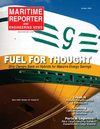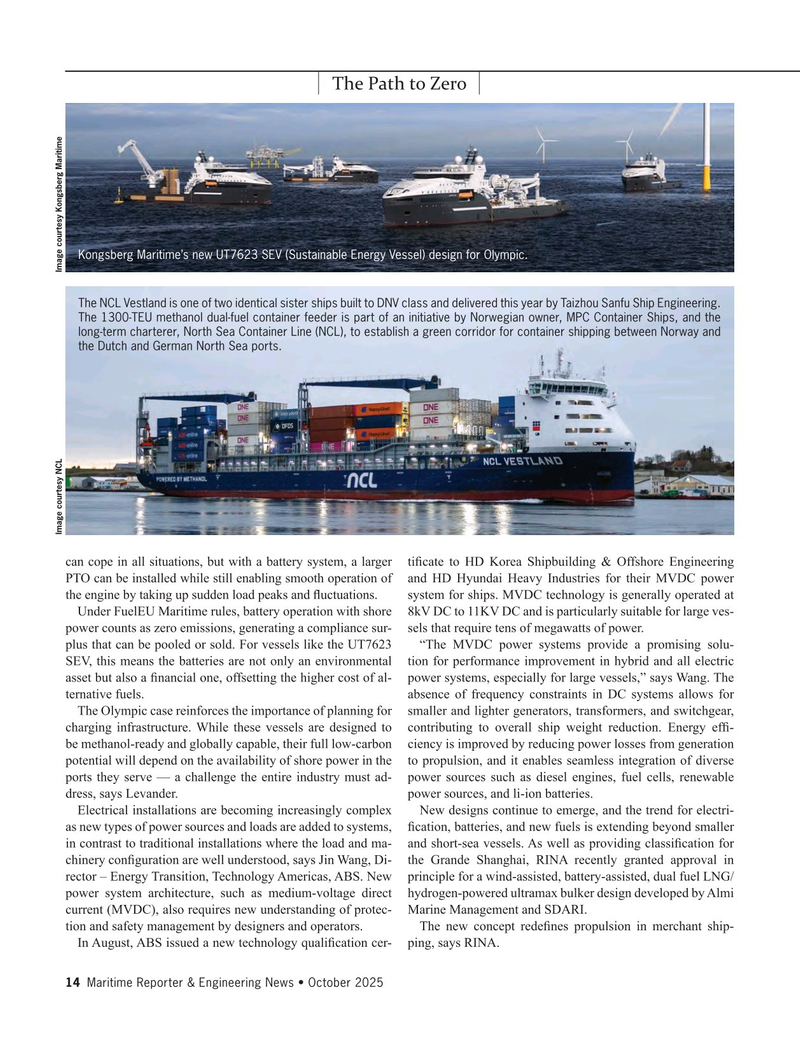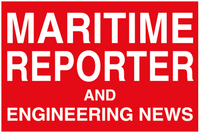
Page 14: of Maritime Reporter Magazine (October 2025)
Read this page in Pdf, Flash or Html5 edition of October 2025 Maritime Reporter Magazine
The Path to Zero
Kongsberg Maritime’s new UT7623 SEV (Sustainable Energy Vessel) design for Olympic.
The NCL Vestland is one of two identical sister ships built to DNV class and delivered this year by Taizhou Sanfu Ship Engineering.
The 1300-TEU methanol dual-fuel container feeder is part of an initiative by Norwegian owner, MPC Container Ships, and the long-term charterer, North Sea Container Line (NCL), to establish a green corridor for container shipping between Norway and the Dutch and German North Sea ports.
Image courtesy NCL Image courtesy Kongsberg Maritime can cope in all situations, but with a battery system, a larger ti? cate to HD Korea Shipbuilding & Offshore Engineering
PTO can be installed while still enabling smooth operation of and HD Hyundai Heavy Industries for their MVDC power the engine by taking up sudden load peaks and ? uctuations. system for ships. MVDC technology is generally operated at
Under FuelEU Maritime rules, battery operation with shore 8kV DC to 11KV DC and is particularly suitable for large ves- power counts as zero emissions, generating a compliance sur- sels that require tens of megawatts of power. plus that can be pooled or sold. For vessels like the UT7623 “The MVDC power systems provide a promising solu-
SEV, this means the batteries are not only an environmental tion for performance improvement in hybrid and all electric asset but also a ? nancial one, offsetting the higher cost of al- power systems, especially for large vessels,” says Wang. The ternative fuels. absence of frequency constraints in DC systems allows for
The Olympic case reinforces the importance of planning for smaller and lighter generators, transformers, and switchgear, charging infrastructure. While these vessels are designed to contributing to overall ship weight reduction. Energy ef? - be methanol-ready and globally capable, their full low-carbon ciency is improved by reducing power losses from generation potential will depend on the availability of shore power in the to propulsion, and it enables seamless integration of diverse ports they serve — a challenge the entire industry must ad- power sources such as diesel engines, fuel cells, renewable dress, says Levander. power sources, and li-ion batteries.
Electrical installations are becoming increasingly complex New designs continue to emerge, and the trend for electri- as new types of power sources and loads are added to systems, ? cation, batteries, and new fuels is extending beyond smaller in contrast to traditional installations where the load and ma- and short-sea vessels. As well as providing classi? cation for chinery con? guration are well understood, says Jin Wang, Di- the Grande Shanghai, RINA recently granted approval in rector – Energy Transition, Technology Americas, ABS. New principle for a wind-assisted, battery-assisted, dual fuel LNG/ power system architecture, such as medium-voltage direct hydrogen-powered ultramax bulker design developed by Almi current (MVDC), also requires new understanding of protec- Marine Management and SDARI. tion and safety management by designers and operators. The new concept rede? nes propulsion in merchant ship-
In August, ABS issued a new technology quali? cation cer- ping, says RINA.
14 Maritime Reporter & Engineering News • October 2025
MR #10 (1-17).indd 14 MR #10 (1-17).indd 14 10/1/2025 1:35:52 PM10/1/2025 1:35:52 PM

 13
13

 15
15
